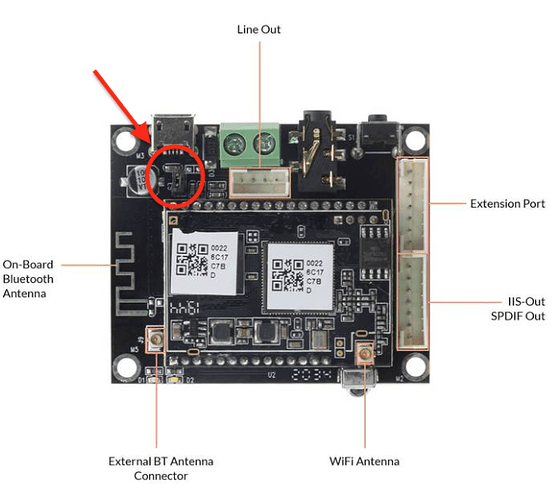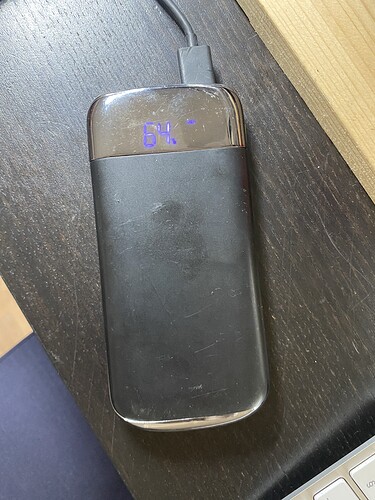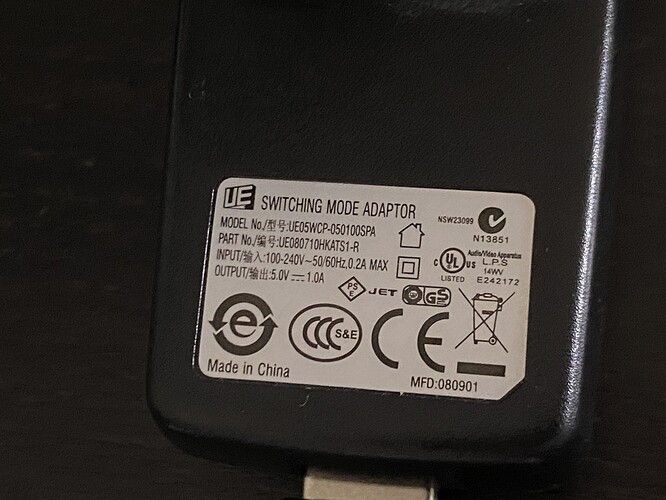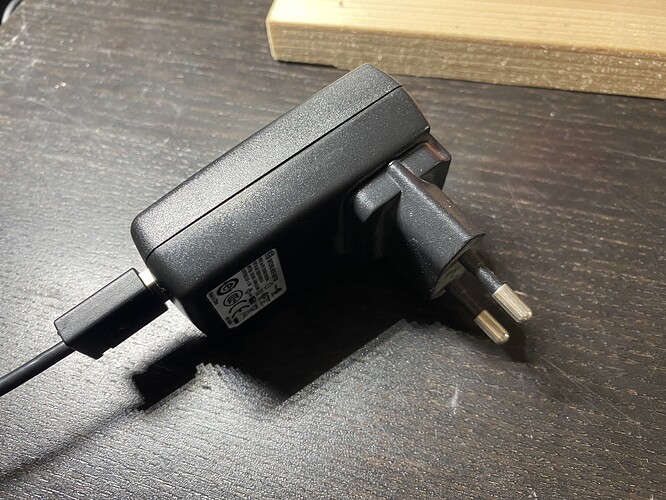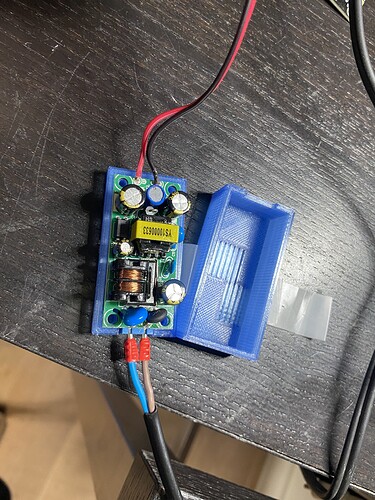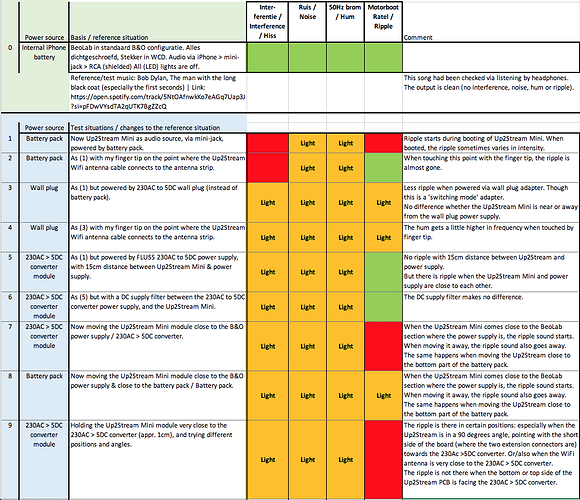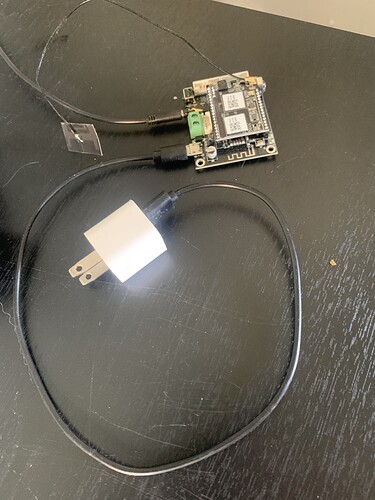@zpl1025 you are genious. Thank you very much, that was exactly what was the problem. When I did unplug the jumper irritating noise was gone. Before yours recomendation I found out that only solution was to use two independent power sources and that was too much for small space I planned for project. Thank you again for help me solving my problem.
@zpl1025: Thanks for bringing the jumper to our attention!
Is this the jumper you are talking about? (within red circle)
- What is actually the function of this jumper? What does it do/how does it work?
- Are you employee of Acrylic or Rakoit?
@zpl1025: thanks also for your suggestion about the Up2Stream Amp.
In this case it won’t work for two reasons:
- Like SimonB mentioned, there is also an active cross-over filter driving the 3 speakers/drivers.
- The whole system and my integration is based on auto Power On & OFF. So the system powers the amplifier only when streaming audio is coming in. When the stream ends, the power of the amplifier switches back to stand by.
Another reason is that I simply like the quality of the built-in amplifier. So I’d like to maintain that amp. 
Thnx again Simon!
Capacitors
Clear, I have ordered some caps and will try when they arrive in a day or two.
10K resistor
Will try that also.
Isolation circuit
I did look at that. And ordered and received these.
In testing them I found out it did not resolve the issue. From other people I heard that it’s better not to use this kind of isolator as they also affect the sound quality.
BeoLab Amp measuring
I will test IC2 also.
I’ll come back with feedback.
I agee with your friends, inserting that filter in would reduce sound quality. If it didn’t reduce the hum, I suspect inserting the decoupling caps will have the same outcome.
It won’t make any difference to you as you have hum even when powering the up2stream from a battery.
This the jumper I mentioned, and it is used to cut the ground for analog and digital to prevent the loop ground when fetch power from the AMP directly.
And yes I’m engineer of Rakoit, glad to help 
Beside the sound quality, the amp2.1 can be configured to drive one 3-way speaker with active crossover, it has 3 channels to drive 3 separated speakers, but it still need a lot of work to get the suitable parameters.
Since my problem is solved and in order not to turn the discussion in the wrong direction, I will just ask the @KolfMAKER: If I understood well you uses the Phono In input on B&O, am I right?
I am asking because, as far as I remember when I worked with similar things, Phono In input has much higher signal amplification than other audio in (that input is for gramophone, and audio signal from gramophone is too weeak) and as I remeber it can make noise if you plug in something other then gramophone. If this is the case, my recomendation si to use another audio input .
From https://en.wikipedia.org/wiki/Phono_input
This “phono input” designed for the millivolt signal from an unamplified turntable should not be confused with the modern standard one-volt line input and output that also uses RCA connectors and is found on video cameras, recorders and similar modern equipment.
@Srdjan_Bajic : Thnx for responding!
To be specific, it is not literally a Phone input. B&O calls it Phono socket, but in fact it is a RCA input. B&O advises to use it to connect non-B&O equipment.
To my experience, there is no noticeable difference in amplification between the RCA and BeoLink (DIN) input.
Agreed. You can see from the circuit diagram that the DIN input is the same as the phono socket input. Both are line level and there’s no RIAA filtering.
RCA plug / sockets are more often called phono plug / sockets. Confusingly many amps call the MM / MC input phono too. I’ve never looked into the historical reason.
@SimonB @KolfMAKER interesting stuff  I’ll have to try and get my head round it sometime. Pretty sure I will come across something in the future similar so really good in depth troubleshooting. Thanks for posting
I’ll have to try and get my head round it sometime. Pretty sure I will come across something in the future similar so really good in depth troubleshooting. Thanks for posting 
Making a re-start
Dear all, this has been a challenging topic to find final resolutions. Thanks for helping me so far!
In the conversations so far, it seemed that the cause of the noise & hum problem was more on the amplifier side. At some point the tests I did and the results I got, became a bit confusing. Therefor I started from scratch again.
Step 1 - Categorizing the disturbing sounds
I redefined the disturbing sounds I heard. With the help of a technician, we (in fact) defined 4 different disturbing sounds:
- Interference/hiss
- Noise
- Hum
- Ripple
Just to make sure we have a clear picture of what disturbances we hear. So later on in testing we can check which ones are there/solved when I change something.
Step 2 - Reconfigure to original
I reconfigured the active speaker (BeoLab) to its original configuration. So I took the Up2Stream Mini, my added power supply and the changed audio wiring all out. And a rewired the active speaker back to its original configuration. This enabled me to check again if the active speaker in its original configuration, had any issues.
Step 3 - Test the basis/reference
For the basis/reference situation I used following:
- Active speaker BeoLab in its original configuration/wiring.
- iPhone with Spotify in Audio Quality in Very High.
- iPhone powered by its own internal battery.
- iPhone connected with a shielded cable (mini-jack to RCA) connected to the RCA input on the active B&O speaker.
- Music ‘The man with the long black coat’ by ‘Bob Dylan’. (On Spotify: Spotify) I checked this music by listening directly through headphones, s-o I am sure this recording is absolutely clean of Interference/Hiss, Noise, Hum or Ripple. Especially in the first seconds, the song is quiet enough to clearly hear any disturbances.
Outcome of the basis/reference test: No interference, no noise, no hum, no ripple!
Step 4 - Testing preparation
One important thing I wanted to test is the influence of the power source used for the Up2Stream Mini. I used and compared 3 different ones (see pictures below):
- Battery pack
- Wall plug (switching type)
- 230v AC to 5v DC converter
Battery pack
Wall plug power supply - label
Wall plug power supply
230v AC > 5v DC converter
Step 5 - Testing
I executed 9 different tests, each with just one change. You can see for each test:
What the test situation was, and the effect to Interference/hiss, Noise, Hum and Ripple. And including some comments. The added overview shows all of this.
Preliminary findings
- The ripple seems influenced by the power supply. Even the battery pack causes ripple, but I guess that has to do with the fact that most battery packs use a step-up-converter that is switching, I have not yet been able to test with a linear power supply.
- The Up2Stream Mini has sensitivity to the nearness of a (switching) power supply. Which I found out by moving it around. The closer to a power supply, the more ripple. It also responded with ripple when near the in internal power supply of the active speaker.
- The position/angle of the Up2Stream Mini, to the power supply also matters. When it is in a standing position towards the top side of the power supply, with the extension connectors towards the power supply, it causes ripple.
And when rotated 90 degrees back again, the ripple (almost) disappears.
Preliminary conclusions
- The ripple seems controllable by the type of power supply (maybe a linear type works best) and by the distance/angle between Up2Stream Mini and power supply.
- The interference/hiss seems mostly under control by using a shielded cable for the audio cable between Up2Stream Mini and the amplifier.
- The noise and hum are still there. Not clear yet how to solve that.
Any suggestion is welcome!
Thinking over again what you mentioned Jason …
You say that you have used a different USB cable in combination with the Apple iPhone charger. So I have two questions about this:
- Did you use the standard Apple iPhone flat 5 volts USB charger (like in the below picture)?
- What kind of USB-to-Micro USB cable did you use, and how is it different?
Hope to hear from you!

Sorry for the delay. I don’t check the forum that often. I suppose that is the 230v 50hz equivalent to the adapter I used. I am in the U.S. so our power is 110-120v at 60hz. Can’t imagine any of that would make a difference as China I believe utilizes the same voltage and hertz as the UK. I just used a standard usb mini cable I had lying around nothing special. A slight hum is still present in my unit so I just decided to use it to send signal to an active subwoofer paired with my light sound speaker. The hum is not noticeable at all at sub frequencies.
Very interesting thread guys. Just chucking in my thoughts here.
I too had some noise from my boards when using with a power amplifier with a direct link from the Arylic board, so any noise produced by the board is amplified 100% by the amp irrespective of the volume setting on the Arylic board.
If you have the volume set on the Arylic board at about 20%, the noise is still amplified by 100%. I added in a cheap volume potentiometer (much like the Arylic one) between the two and turned the dial down to about 70% which attenuated the incoming signal and noise to the power amp and in my case reduced the noise to a point where on my setup I couldn’t hear it but the music was plenty loud enough.
I am sure you can also imagine that this would reduce the overall available volume but in reality all this means is that you need to set the volume in the Arylic higher, to say about 50% to achieve the same output volume - in reality you’d never have the Arylic up at 100% as it would distort on pretty much any setup.
If you had a standard integrated amplifier with a built in volume control and had the Arylic plugged it you wouldn’t crank the amp volume right up - if you did you’d expect to get noise; even if you had a top grade CD player that would happen.
I am sure some purists will disagree with me and I do agree that it is best to eliminate noise at source but you have to work pretty hard to get to total silence. There are many ways to chip away at noise here and there but this is a simple way to chip a bit further if you still have that tiny bit of hiss and hum.
So in short, my recommendations are:-
-
Put a volume control inline between the board and amplifier.
-
Do not use a switched mode PSU as they are inherently noisy and not good for audio.
Use a linear power supply. Easily built with a 7805, mains transformer, bridge rectifier and a couple of capacitors. Cheap too! 7805 Voltage Regulator IC Circuit Working and Applications (electronicshub.org)
It’s also pretty easy to tap off the internal DC power supply of an amp and shove the voltage through a 7805 to get you a 5v supply.
As always in audio circuits, keep the PSU as far away as possible from the board.
- Always used screened audio link cables.
@Jzad
Hi Jason, I am still working on eliminating ripple and hum distortions.
You recommended to try the Arylic DAC extension board, together with shielded RCA cables.
Currently I use the Up2Stream mini without the DAC extension board, but with high quality shielded audio cable. I have the cable connected to the Up2Stream Mini via mini-jack. Then there still is ripple and hum.
You mentioned that the onboard mini-jack connector on the Up2Stream Mini, does not have very good quality. And that adding the DAC extension board could help improve.
Questions
- Can you give some background info why you expect the DAC extension board to help eliminate distortions?
- Do you in the meantime have experience with the DAC extension board?
Wow. Took me awhile to catch up where we are at on this thread. Like I said, I only use mine with a subwoofer so it’s not used in a critical listening application. I haven’t spent much time with the mini because it is what is is for me. Works for my application so haven’t spent much time with it. I recommended the dac just as an alternative. No real thought behind it just another option. So it seems like the issue you are still having is noise-hum? I really wish you could capture a video with audio of the symptom. Without being able to actually hear the symptom I think we are just guessing. A ground loop hum and a hum that is inherant to the amplified audio signal path sound a bit different. How audible is it at this point? What frequency? I found it interesting that you had clean signal output to headphones from the mini but it hums when connected to your powered speakers. You also mentioned that the hum is heard through the mids driver on your speaker. That in itself is very interesting in my opinion and should be further investigated. Especially when you say the unit is 10-15 years old as caps can fail at this age. The voice coil on the driver could have an issue as well or there could be corrosion or wiring issues from crossover to driver? Can you isolate drivers by disconnecting from the crossover? Is it in both speakers mid drivers or just one? It really seems like a lot of the problem lies with in power and signal chain proximity to each other. Also I just noticed that you are having hum issues with a pair of s10’s as well. Have you metered your power at the socket you are plugging into? Is it clean. Is there any voltage on the neutral or ground? Do you have a line conditioner or any way to isolate ground? I would say it is safe to assume the mini works as Spec’d. I would be looking deeper into the powered speakers to make sure they are functioning to spec.
Another thing I thought of although super basic is how does the gain stage of the powered speakers amplifier work? Can you adjust it? Does the amplifier gain affect the noise you are hearing? How does it work in relation to volume adjust from the 4STREAM app?
This is smart. Kinda the path I was leading down reading this thread over again.
I had a similar problem with various speakers I have built both with and without arylic boards. The best solution I have found is using a Ground Loop Noise Isolator. This significantly helps remove the problem but at extra loud volumes it can still be slightly reduced. The only other thing I have done is add special shielding to all the wires and ground them out.
